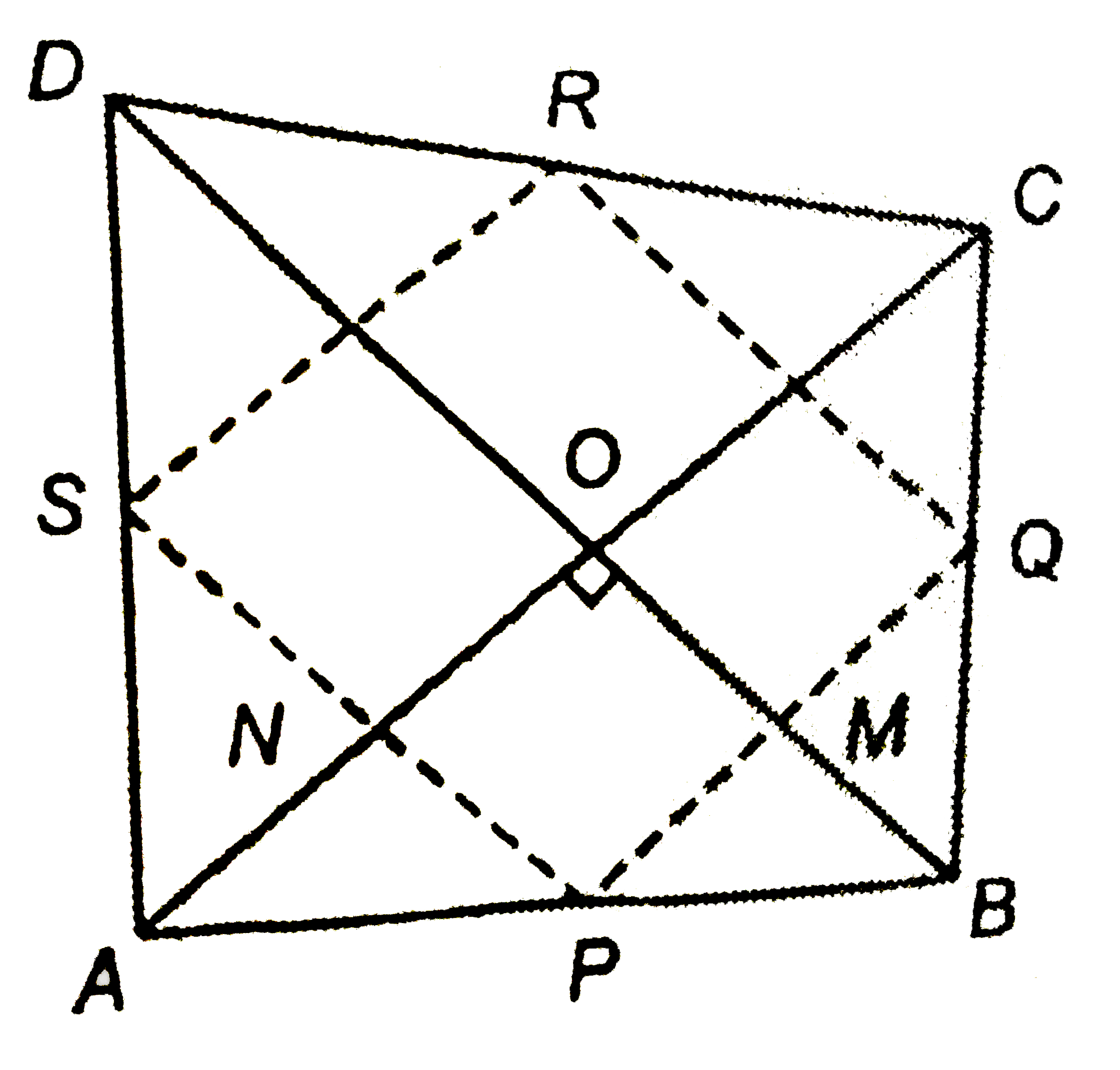Prove that the quadrilateral formed by joining the mid-points of the pairs of consecutive sides of a quadrilateral is a parallelogram.
To prove that the quadrilateral formed by joining the midpoints of the pairs of consecutive sides of a quadrilateral is a parallelogram, we will follow these steps:
Step 1: Define the Quadrilateral and Midpoints
Let A, B, C, and D be the vertices of the quadrilateral. The midpoints of the sides AB, BC, CD, and DA are denoted as P, Q, R, and S respectively.
Step 2: Express the Midpoints in Vector Form
Using position vectors, we can express the midpoints as follows:
- P=→A+→B2 (midpoint of AB)
- Q=→B+→C2 (midpoint of BC)
- R=→C+→D2 (midpoint of CD)
- S=→D+→A2 (midpoint of DA)
Step 3: Find the Vectors →PQ and →SR
Next, we need to find the vectors →PQ and →SR:
- The vector →PQ is given by:
→PQ=→Q−→P=(→B+→C2)−(→A+→B2)=→C−→A2
- The vector →SR is given by:
→SR=→R−→S=(→C+→D2)−(→D+→A2)=→C−→A2
Step 4: Show that →PQ is Parallel to →SR
From the calculations above, we can see that:
→PQ=→SR
This means that →PQ is parallel to →SR.
Step 5: Show that →QR is Parallel to →SP
Now, we will find the vectors →QR and →SP:
- The vector →QR is given by:
→QR=→R−→Q=(→C+→D2)−(→B+→C2)=→D−→B2
- The vector →SP is given by:
→SP=→P−→S=(→A+→B2)−(→D+→A2)=→B−→D2
Step 6: Conclude that →QR is Parallel to →SP
Since →QR=−→SP, we can conclude that →QR is also parallel to →SP.
Final Conclusion
Since we have shown that both pairs of opposite sides →PQ∥→SR and →QR∥→SP, we can conclude that the quadrilateral PQRS is a parallelogram.
Let A, B, C, and D be the vertices of the quadrilateral. The midpoints of the sides AB, BC, CD, and DA are denoted as P, Q, R, and S respectively.
Using position vectors, we can express the midpoints as follows:
- P=→A+→B2 (midpoint of AB)
- Q=→B+→C2 (midpoint of BC)
- R=→C+→D2 (midpoint of CD)
- S=→D+→A2 (midpoint of DA)
Next, we need to find the vectors →PQ and →SR:
- The vector →PQ is given by:
→PQ=→Q−→P=(→B+→C2)−(→A+→B2)=→C−→A2
→SR=→R−→S=(→C+→D2)−(→D+→A2)=→C−→A2
From the calculations above, we can see that:
→PQ=→SR
This means that →PQ is parallel to →SR.
Now, we will find the vectors →QR and →SP:
- The vector →QR is given by:
→QR=→R−→Q=(→C+→D2)−(→B+→C2)=→D−→B2
→SP=→P−→S=(→A+→B2)−(→D+→A2)=→B−→D2
Since →QR=−→SP, we can conclude that →QR is also parallel to →SP.
Since we have shown that both pairs of opposite sides →PQ∥→SR and →QR∥→SP, we can conclude that the quadrilateral PQRS is a parallelogram.
Topper's Solved these Questions
Similar Questions
Prove that the figure formed by joining the mid-points of the pair of consecutive sides of a quadrilateral is a parallelogram. OR ABCD is a parallelogram in which P,Q,R and S are mid-points of the sides AB,BC,CD and DA respectively. AC is a diagonal. Show that : PQ∣∣AC and PQ=12AC SR∣∣AC and SR=12AC PQ=SR (iv) PQRS is a parallelogram.
View SolutionShow that the quadrilateral formed by joining the mid-points of the consecutive sides of a rectangle is a rhombus.
View SolutionShow that the quadrilateral formed by joining the mid-points of the consecutive sides of a rectangle is a rhombus.
View SolutionShow that the quadrilateral formed by joining the mid-points of the consecutive sides of a rectangle is a rhombus.
View SolutionShow that the quadrilateral, formed by joining the mid-points of the sides of a square is also a square.
View SolutionShow that the quadrilateral, formed by joining the mid-points of the sides of a square, is also a square.
View SolutionShow that the quadrilateral, formed by joining the mid-points of the sides of a square is also a square.
View SolutionThe diagonals of a quadrilateral ABCD are mutually perpendicular . Prove that the quadrilateral formed by joining the mid-points of its consecutive sides is a reactangle.
 View Solution
View SolutionShow that the quadrialteral formed by joining the mid-points of the consecutive sides of a rhombus, is a rectangle.
View SolutionThe diagonals of a quadrilateral intersect at right angles. Prove that the figure obtained by joining the mid-points of the adjacent sides of the quadrilateral is a rectangle.
View Solution

